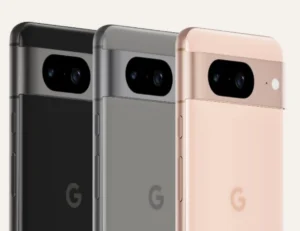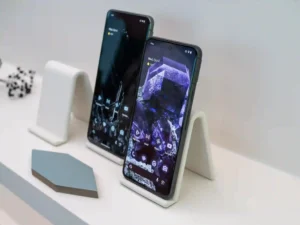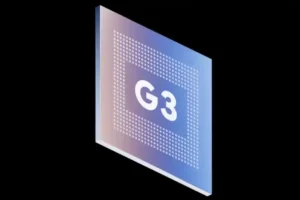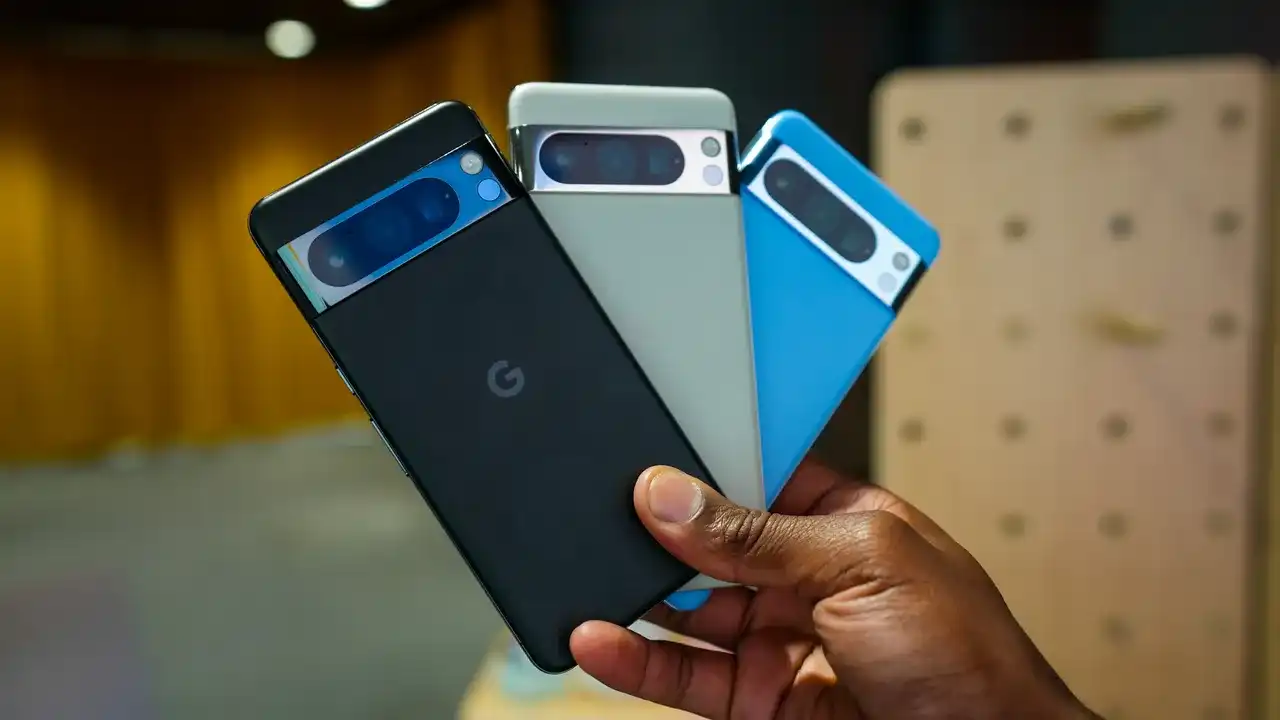Google Unveils Pixel 8 Pro: A Serious Contender Against Galaxy and iPhone.At the much-anticipated ‘Made by Google’ event, Google introduced its latest offerings: the Pixel 8 and Pixel 8 Pro smartphones.
While the exterior design may not have undergone a radical transformation from their predecessors in the Pixel 7 and Pixel 6 series, these new devices come armed with significant camera upgrades and innovative AI-driven features that aim to challenge the dominance of Apple and Samsung in the smartphone market.
The Pixel 8 series continues the tradition of offering two models: a standard edition and a larger Pro variant. Despite the familiar appearance, Google has invested heavily in infusing the Pixel 8 and 8 Pro with cutting-edge AI technology, including the ability to remove unwanted background noise from your videos. In this article, we delve into the key features and share our initial impressions of these new additions to the Pixel lineup.”
Refined Design and Build
With the release of the Google Pixel 8 and Pixel 8 Pro, Google has subtly reimagined the hardware, departing from the design language of the Pixel 7 series. Notable changes include the introduction of smoother, rounded corners, enhancing the ergonomics of these devices compared to their more angular predecessors, the Pixel 7 and 7 Pro.
The standard Pixel 8 boasts dimensions of 5.9 x 2.8 x 0.4 inches (HWD) and a weight of 6.6 ounces. This translates to a slight reduction in height by 0.2 inches and weight by 0.35 ounces when compared to the Pixel 7. However, it is marginally thicker by 0.06 inches. For those yearning for a return to more compact smartphones, the Pixel 8 delights with its comfortably petite form factor, facilitating effortless one-handed use.
In contrast, the Pixel 8 Pro embraces a larger footprint, measuring 6.4 x 3.0 x 0.3 inches and weighing 7.5 ounces. This configuration renders it slightly thinner by 0.05 inches while marginally heavier by 0.02 ounces compared to the Pixel 7 Pro.
The soft-touch finish on the rear ensures a secure grip, despite the device’s relatively broad profile. Notably, the Pixel 8 Pro ditches the curved display of its predecessor, the Pixel 7 Pro, in favor of a flat panel akin to the Pixel 8.

This alteration is likely to be well-received by users who found the curved edges of the Pixel 7 Pro to be less user-friendly. Additionally, both Pixel 8 models feature IP68 ratings, signifying their resistance to dust and their ability to withstand brief submersion in water.
Google has maintained its commitment to premium materials, with Corning Gorilla Glass Victus safeguarding the Pixel 8 and Victus 2 protecting the Pixel 8 Pro. Both smartphones incorporate an aluminum frame and a distinctive camera bar, with the Pixel 8 sporting a matte finish, while the Pixel 8 Pro opts for a polished one.”
Revamped Camera Bar Design
One noticeable design evolution in the Pixel 8 Pro can be observed in its camera bar. Unlike its predecessor, the Pixel 7 Pro, which featured separate elements for each camera, the Pixel 8 Pro adopts a unified approach, housing all of its cameras within a single, pill-shaped section.
Notably, nestled beneath the camera bar’s flash is an additional sensor, a thermometer. Google touts its ability to measure the temperature of nearby objects, roughly within a 1-inch proximity.
Our initial tests of this feature indicate its effectiveness, but its practical utility in the long term remains a question. Many users might have preferred the thermometer to display ambient temperature, which it currently does not. Both smartphones exhibit exceptional build quality, displaying a harmonious blend of materials and meticulous craftsmanship.
A Splash of Color
The Pixel 8 Pro offers an updated color palette, introducing Bay (a light blue shade) in place of Hazel, alongside Obsidian (black) and Porcelain (white), replacing Snow. The addition of Bay adds a refreshing touch to the Pro lineup, injecting some vibrant variety.
However, it’s the matte black Obsidian variant that truly captures attention with its sleek appearance. Notably, the rear glass sports a soft-touch finish, imparting the Pro’s hues with a matte finish that tastefully contrasts with the glossy frame and camera bar.
Conversely, the standard Pixel 8 bids farewell to Lemongrass and Snow, opting for Hazel (a grayish tone), Obsidian, and Rose (pink) instead. These color choices exude a touch more vibrancy, thanks to the reflective glass finish on the back, which elegantly complements the matte frame.
While the color options are pleasing, some users may have hoped for a more extensive selection in both the Pixel 8 and 8 Pro. Nevertheless, these devices continue to demonstrate Google’s commitment to crafting smartphones that blend style and substance.”
Brilliant Displays
The Pixel 8 lineup boasts stunning screens that bear a resemblance to last year’s displays but come with subtle enhancements. The Pixel 8 features a 6.2-inch display with a resolution of 2,400 by 1,080 pixels, offering a pixel density of 428ppi. Notably, its refresh rate can dynamically shift between 60Hz and 120Hz.
While the resolution remains consistent with the Pixel 7, the Pixel 8’s screen is slightly more compact by 0.1 inches, resulting in a marginally higher pixel density. What sets the Pixel 8 apart is its improved refresh rate, surpassing the Pixel 7’s maximum of 90Hz.
This translates to even smoother animations and interactions on the Pixel 8. Furthermore, the Pixel 8 boasts an average brightness of 1,400 nits, a figure that was previously the Pixel 7’s peak brightness.
In direct sunlight, the Pixel 8’s peak outdoor brightness soars to an impressive 2,000 nits, significantly enhancing visibility and usability outdoors. With these enhancements, the Pixel 8’s screen stands on par with the displays of the iPhone 15 Pro and Samsung Galaxy S23+.
On the Pro side, the lineup maintains the 6.7-inch screen size from the previous year, albeit with minor adjustments. The Pixel 8 Pro’s display offers a resolution of 2,992 by 1,344 pixels, providing a pixel density of 489ppi.
Its refresh rate spans from a mere 1Hz to a fluid 120Hz. While this resolution is slightly lower than the Pixel 7 Pro’s 3,120 by 1,440 pixels and 512ppi density, in practical usage, they exhibit nearly identical sharpness and clarity on the Pixel 8 Pro’s screen.
Regarding brightness, the Pixel 8 Pro outshines its predecessor with an average brightness of 1,600 nits, surpassing the 7 Pro’s maximum output of 1,500 nits. Impressively, the Pixel 8 Pro’s peak brightness reaches a remarkable 2,400 nits, positioning its display as one of the most visible in outdoor conditions.

The smartphones feature minimal bezels, creating an all-screen front appearance, except for the punch hole at the top that houses the selfie camera.
Examining the device’s layout, you’ll find a power button and volume rocker on the right side, while the left side houses the SIM tray. The bottom section accommodates speaker grilles and a USB-C port (USB 3.2) for charging and data transfer.”
Enhanced AI with Tensor G3
Both the Pixel 8 and Pixel 8 Pro benefit from Google’s in-house Tensor G3 system-on-a-chip (SoC). While this line of SoCs may not outshine others in benchmark tests, its primary emphasis lies in delivering advanced AI capabilities.
The Tensor G3 significantly enhances the Pixel 8’s functionality by boosting features like call screening and image processing. It plays a crucial role in enabling the Audio Magic Eraser feature, which effectively eliminates unwanted background noise from videos.
This intelligent feature can distinguish between speech, noise, music, nature sounds, and crowds, offering a promising solution for enhancing video quality. During the demo at the event, the Audio Magic Eraser showcased its potential, leaving us eager to explore its practical applications.
The Tensor G3 also powers Google’s innovative Best Take feature, which offers the ability to recompose images by replacing faces. In a scenario demonstrated by Google, a group photo featuring individuals not looking at the camera or displaying their best expressions could be transformed.

With the Pixel 8, the phone identifies similar images and suggests alternative expressions from other photos. Users can then choose which faces to replace individually, ensuring that family or group photos are filled with smiling, happy faces. While we didn’t have the opportunity to test this feature firsthand, we anticipate its potential utility.
Google proudly highlights that the machine learning model integrated into the Pixel 8 series is ten times more intricate than the initial Tensor introduced with the Pixel 6. Furthermore, the Titan M2 security coprocessor, a feature carried over from the Pixel 7, continues to play a pivotal role in securing biometric data and other sensitive information on the phone.
One notable security feature is the secure face-unlock feature, now more robust and reliable. It can be utilized even in sensitive scenarios such as banking and payments, surpassing previous versions of face unlock available on Pixel phones.
Unlike the basic face-recognition tool employed in the Pixel 6 and Pixel 7, which could be fooled by photos and other simple methods, the Pixel 8 series offers enhanced security. For users who prefer alternatives, both Pixel 8 models retain a convenient fingerprint sensor embedded under the display.”
Google Pixel 8 Pro in Porcelain: Connectivity and Beyond
In terms of connectivity, both Pixel 8 models offer a comprehensive range of options to keep you connected seamlessly. You can count on Bluetooth 5.3, NFC, sub-6GHz, and mmWave 5G support, as well as Wi-Fi 7 for high-speed wireless connections.
Notably, the Pixel 8 Pro is equipped with an ultra-wideband chip, enhancing spatial orientation capabilities. This addition enables you to precisely locate compatible devices with greater accuracy—a feature absent in the regular Pixel 8.
When it comes to battery life and charging, expect a performance on par with last year’s phones, ensuring you stay powered up and ready for whatever comes your way.”
“Enhanced Photography with Smarter Cameras
The Pixel 8 and Pixel 8 Pro have stepped up their camera game with impressive improvements. The primary shooters on both models feature 50MP sensors, but the Pixel 8 Pro’s sensor takes it a step further by allowing in up to 21% more light.
Additionally, both ultra-wide cameras now boast autofocus capabilities, although the Pixel 8 is equipped with a 12MP ultra-wide camera, while the Pixel 8 Pro boasts a substantial 48MP ultra-wide camera.
This is a significant upgrade from the Pixel 7 Pro’s 12MP ultra-wide camera. Google claims that the 48MP ultra-wide camera on the Pixel 8 Pro is 105% more sensitive to light than its predecessor.
Autofocus performance also sees a boost on the Pixel 8 Pro, thanks to a multi-zone laser detect autofocus (LDAF) system, ensuring rapid focus no matter where your subject is in the frame. On the other hand, the regular Pixel 8 features a single-zone LDAF.
The Pixel 8 Pro doesn’t stop there; it introduces a 48MP telephoto shooter that lets in 56% more light than before. These enhancements collectively translate to capturing better-looking photos even before Google’s powerful algorithms come into play.
Both the Pixel 8 and 8 Pro’s front-facing cameras now offer a wider field of view, increasing from 92.8 degrees to 95 degrees. This subtle change allows you to capture a bit more of your surroundings in your selfies. The selfie camera itself features a 10.5MP sensor, slightly lower than the 10.8MP shooter on the Pixel 7 series.
However, the true difference in image quality often relies on advanced image processing, so these variations may not be readily noticeable to the average user. Notably, the Pixel 8 Pro’s selfie camera boasts autofocus, while the Pixel 8’s remains fixed focus.

Google has some exclusive camera-related features reserved for the Pixel 8 Pro. Within the camera app, users will find Pro controls that provide quick access to focus, shutter speed, and ISO settings. Additionally, the Pro model offers focus peaking, a useful tool for ensuring your subject is in focus.
A manual zoom selector lets you directly choose from the three available cameras. Some features, such as Night Sight video and Video Boost, will arrive on the Pixel 8 Pro through a software update later this year. These tools enhance low-light video capture and introduce HDR+ capabilities to elevate your videography experience.”
Extended Support and Pricing Details
Google is doubling down on its commitment to Pixel users, offering an impressive seven years of support for the Pixel 8 and Pixel 8 Pro. This comprehensive support package encompasses OS upgrades, security updates, and feature enhancements, and it’s set to extend until 2030. It’s a notable leap from the four to five-year support typically provided for older Pixel devices.
While this extended support is a remarkable selling point, it’s worth noting that Google has occasionally backtracked on such promises in the past. Therefore, we approach this seven-year pledge with cautious optimism.
For those planning to keep their Pixel 8 for an extended period, the amount of RAM and storage is a crucial consideration. The Pixel 8 offers 8GB of RAM and storage options of 128GB or 256GB. While it would have been preferable for the baseline storage to start at 256GB, this isn’t the case.
On the other hand, the Pixel 8 Pro steps up the game with 12GB of RAM and a range of storage options, including 128GB, 256GB, 512GB, and an impressive 1TB model—although the 1TB variant is exclusively available in the US.
In terms of pricing, the Pixel 8 starts at $699, offering an attractive balance of features and affordability. Meanwhile, the base model of the Pixel 8 Pro is priced at $999. Preorders for both models are now open, with in-store availability scheduled to commence on October 12th. Google is sweetening the deal by offering a set of Google Pixel Buds Pro for free with Pixel 8 preorders.
Additionally, if you choose to preorder the Pixel 8 Pro directly from Google, you’ll receive a complimentary Pixel Watch 2, adding even more value to your purchase.”


